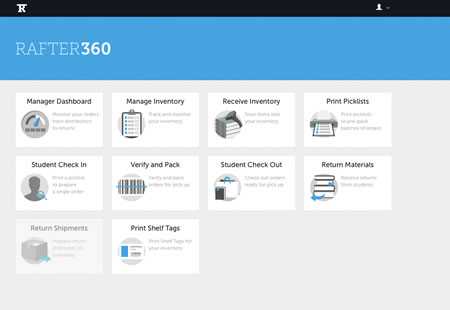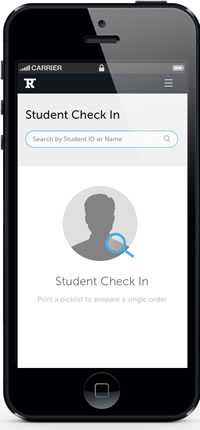Three critical services can help attract and retain today’s students—and raise efficiency and lower costs.
 As campus IT departments move to on-demand models—ecosystems that support fully-customized and personalized options—for student services and campus functions, it’s also critical to provide these services at a lower over-time cost.
As campus IT departments move to on-demand models—ecosystems that support fully-customized and personalized options—for student services and campus functions, it’s also critical to provide these services at a lower over-time cost.
While a full-blown on-demand model may not be feasible for all institutions at the moment, there are technologies available today that can be part of an on-demand approach to students services. Below we describe a few.
Textbook services
With the spiraling cost of course materials burdening students and institutions, Rafter, a course materials management company [previously known as BookRenter], offers Rafter360™ –a tech-based solution that enables a textbooks-in-tuition model for any campus.
After students register for their courses, they are automatically provided 100 percent of their required materials for class,. Two colleges currently using Rafter360, Thomas More College in Kentucky and Schreiner University of Texas, have already reported students saving 55 percent and 54 percent respectively on the costs of textbooks.
(Next page: Mobile services)
For students, Rafter360 offers a flat rate price that has the potential to save them over 50 percent of traditional costs. This reduced fee is factored directly into their tuition, making course materials a predictable and budgeted expense, notes the company. Rafter360’s price is individualized per school based on a proprietary algorithm that takes into account each school’s unique historical textbook adoption and course enrollment data.
“It was clear there needed to be a better way to take control over the skyrocketing costs of textbooks and make sure that students have the content and materials they need to be successful,” said Sara Leoni, CEO of Rafter. “With Rafter360, we changed the game by designing the program to fully automate the course materials process. We looked painstakingly at every angle to make sure our solution would benefit all stakeholders – students, faculty, and campuses – with greatly reduced costs for students, freedom of choice for faculty when choosing course materials, and ease-of-use for administration and staff.
With Rafter360, once a student is registered for their courses, professors assign materials (in print or digital format) and the system then manages the process “seamlessly behind the scenes,”. “All students need to do is pick up their package of materials waiting for them at the campus bookstore or the campus can opt to have the entire order sent to students’ homes. Students log in to the system to start using any digital materials. Based on a library model, when the academic session is over, students return the textbooks to the campus store and keep or recycle used workbooks and trade materials.”
Rafter360 says that it aims to help colleges differentiate themselves as student advocates and technology innovators, as well as create a path to the future as instructional materials evolve from print textbooks into digital experiences.
According to Bill Muse, VP of Administration and Finance at Schreiner University, “For Schreiner to get on the leading edge like we have by offering a books-in-tuition solution, it was really critical that we were able to partner with a provider like Rafter. We could not have done this on our own. Students love the convenience and the level of service in the bookstore. It’s a win-win and we are delighted.”
Mobile services
Consider it almost like Amazon, but for staff and student services on campus.
According to the University of Maryland, which has partnered with rSmart and Internet2, the University will provide access to approximately 130 campus services in one location, from any computer or mobile device.
With search and app-store-like features, the newly launched platform aims to simplify access (while reducing maintenance and personnel costs), to services ranging from class registration to email, and replicates the communication capabilities and online shopping experiences people are accustomed to using.
“The central question of the cloud-based solution is ‘What would you like to do?,’ and it offers UMD’s more than 37,000 students and 9,000 faculty and staff one-stop shopping for Web apps and services, the ability to personalize their view by picking favorites, opportunities to provide service feedback–including the option to rank UMD services with stars–and more,” said a University spokesperson in a statement.
The new platform, One.UMD replaces the MyUMD portal, with the goal of enhancing access to University services provided by the Office of the Senior Vice President of Academic Affairs and Provost, the Division of Student Affairs, the Division of Information Technology, and others.
“We are partnering throughout the university to give Maryland students, faculty, and staff a central location where they can quickly search and connect with university services ranging from making transcript requests to getting the campus map in an online marketplace format,” said University of Maryland Vice President and CIO Eric Denna.
UMD’s Division of Information Technology will continue to work with UMD partners to include additional university services on the new platform. rSmart’s OneCampus is available to the University of Maryland and to all of Internet2’s higher education members as part of Internet2’s NET+ initiative.
The decision to create the new platform also came as the University realized smartphone and tablet use continues to rise, and needed an efficient and cost-effective way to organize its Web-based services. UMD says that OneCampus offers the ability to collect “valuable user feedback to help further strengthen university service offerings and the ways those services are delivered.”
Maryland was first introduced to the OneCampus solution in its role as a participant in Internet2 NET+. UMD joined technology leaders from Indiana University, the University of Utah, the University of Pittsburgh, Clemson University, the University of Nebraska Omaha, and Brigham Young University-Idaho to collaboratively guide and shape the Internet2 NET+ OneCampus offering for higher education institutions.
“After completing the Internet2 NET+ service validation process, we recognized that OneCampus has the potential to transform how we deliver application services to our stakeholders,” said Denna. “The modern platform and search functionality will allow our campus community to quickly find and access a wide range of services and applications from any device.”
(Next page: Career services)
Career services
Recently, institutions have begun to think about transcripts as bridging documents between diplomas and e-portfolios. Many colleges and universities are reimagining traditional transcripts in both form and substance—and at a lower cost—from paper sent through mail to electronic images or standardized data exchanged securely online and extended to document a lifetime of learning.
But the first benefits of electronic transcripts for any institution are efficiency and cost. By implementing Parchment eTranscripts, Furman University says it was able to decrease processing time from 4 to 6 hours daily to only 30 minutes, a time savings of 87 percent.
Taking transcript requests is now 100 percent automated at Furman, which saves data entry time. Plus, Parchment allows Furman to collect a small $5 processing fee from students, which takes the cost burden off the university and also provides a deterrent to students ordering transcripts frivolously.
“Furman has paid nothing out of pocket for our Parchment Send solution,” explained Brad Barron, associate dean and registrar at Furman. “From implementation to sending 20,000 transcripts, it hasn’t cost us a cent. Our CFO has not been disappointed with me when I say that this Parchment solution only makes us money. It doesn’t cost us anything.”
According to Barron, the University fully integrated Parchment’s solutionin less than 4 months. “If you are familiar with how IT integrations work, that’s amazing,” he emphasized. “Parchment has been a fantastic solution for Furman, including how the solution interfaces effectively with our enterprise-wide administrative system, Ellucian Colleague.”
- 25 education trends for 2018 - January 1, 2018
- IT #1: 6 essential technologies on the higher ed horizon - December 27, 2017
- #3: 3 big ways today’s college students are different from just a decade ago - December 27, 2017



